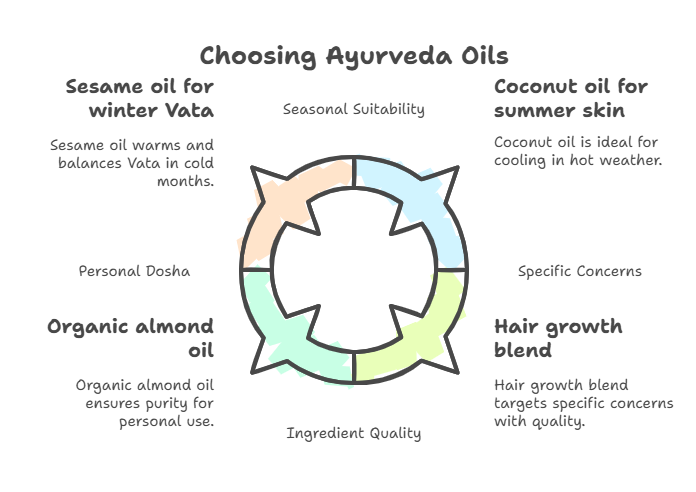Ayurveda oil holds a special place in traditional Indian medicine, used for thousands of years. This old practice focuses on overall wellness. It provides natural solutions for various health and beauty needs.
Ayurveda oil is gaining popularity worldwide. It’s used for nourishing hair treatments and relaxing body massages. Many people believe in its benefits.
“Ayurveda teaches us to live in harmony with ourselves, others, and the environment to achieve true well-being.”
Ayurvedic Principle
Ayurveda oil is becoming popular. Many people want natural options for their health.
These oils are known for improving hair and skin health using gentle, natural means. What makes these specific oil oil blends effective, and how can we use them daily?
Ayurveda oil is important in the ayurveda system. Let’s look at its history, uses, and benefits.
Understanding these oils can help you integrate them into your self-care practices effectively. This guide covers the essentials of this traditional approach.
The Ancient Wisdom of Ayurveda Oil
Ayurveda, translating to “the science of life,” is a complete healing system from India, dating back over 5,000 years.
It focuses on balancing the mind, body, and spirit using natural remedies, diet adjustments, and lifestyle choices. Ayurveda oil is vital in this system, acting as a carrier for potent herbs and nutrients.
These therapeutic oils are typically created by infusing herbs, roots, and flowers into a base like sesame oil, coconut oil, or almond oil.
This process yields a powerful blend containing the healing properties of the `ayurvedic ingredients` used. Practitioners believe specific oils help balance the doshas – Vata, Pitta, and Kapha – which influence our physical and mental states.
Understanding your dosha can guide you in selecting the most beneficial `ayurveda oils` for your constitution. This personalized approach is central to Ayurvedic philosophy. The careful selection of herbs and base oils makes each preparation suitable for different needs and body types.
The Many Uses of Ayurveda Oil
Ayurveda oil is remarkably adaptable, used for everything from skin health to digestion support. Its versatility stems from the diverse properties of the herbs and oils combined. Here are some primary applications:
Hair Care
Using `ayurvedic hair oil` is perhaps its most widely known application in modern `hair care`. Many trust oils like amla, bhringraj, and coconut oil to `promote hair` growth and support `healthy hair`. These oils can also help manage dandruff and improve overall hair texture and shine.
Regular `hair oiling` nourishes the scalp, strengthens roots, and can prevent `hair loss` or address concerns about `damaged hair`.
Products like the Indē Wild Champi Hair Oil exemplify modern blends using traditional `ayurvedic ingredients`. This specific `hair oil` contains castor oil, hibiscus, and brahmi, formulated to fortify `natural hair` from root to tip, leaving `hair soft` and manageable.
Using these `ayurveda oils` can also help `tame frizz` and `add shine`, making hair look healthier and more vibrant. Choosing the right oil depends on your specific `hair concerns` and `hair texture`. Consistent use is often recommended for best results in achieving `moisturizing hair` benefits.
Skin Care
Ayurveda oils are also valued for nourishing the skin, providing deep hydration, especially for `dry skin`. Oils such as neem, turmeric, and sandalwood are common in addressing various skin issues, including acne and signs of aging. These `body oils` help moisturize, reduce inflammation, and encourage a radiant complexion1.
Unlike some commercial body lotion or body cream options, Ayurveda oil for the skin often embraces pure, clean beauty principles. Many prefer skin oil for its natural composition and its ability to penetrate deeply, nourishing from within. Integrating body care with oils like rose oil or sweet almond oil can enhance skin health in a holistic way. This aligns with the broader philosophy of natural wellness, which also supports using herbal adaptogens like Rhodiola for weight loss and energy balance.
Ayurvedic `face creams`, `face wash`, and even `face masks` often incorporate these beneficial oils. Some users find `oil body` applications provide longer-lasting moisture than conventional products. These `body creams` and oils align with the `ancient indian` approach to holistic wellness.
Massage and Relaxation
Abhyanga, the practice of self-massage with warm `massage oil`, is fundamental to Ayurvedic daily routines. This ritual enhances `blood circulation`, soothes the nervous system, and fosters general well-being. It’s a simple yet profound way to `balance mind` and body.
Different `ayurveda oils` are suggested based on your dosha and specific needs, like muscle tension or joint stiffness. Using the right `body oil` for massage can make the experience more effective. This form of `body care body` is deeply relaxing and rejuvenating2.
The warmth of the oil combined with gentle strokes helps release physical and mental stress. It’s a key part of `body body care` in Ayurveda. Consider exploring `gift sets` that include massage oils tailored to different needs.
Internal Use
Though less frequent in Western practices, certain `ayurveda oils` are ingested for health purposes. Ghee (clarified butter), for instance, is widely used as a medium for herbs. It’s believed to enhance digestion and nourish the body’s tissues from within3.
Some base oils like `sesame oil` or `coconut oil` might also be used in specific internal preparations, but caution is advised. Using oils internally should ideally be done under the guidance of a qualified Ayurvedic practitioner. Note that `cooking oil` applications differ significantly from therapeutic internal use.
It’s crucial to distinguish between oils meant for external application (`body body care body`) and those prepared for safe ingestion. Always verify the oil’s intended use. Remember that sites offering products should have a clear `privacy policy` and `cookie policy` regarding usage information.
Popular Ayurveda Oils and Their Benefits
Understanding individual oils helps in making informed choices for your `hair care` and `body care` routines. Many oils offer overlapping benefits but possess distinct properties. Here’s a closer look at some commonly used `ayurveda oils`:
| Oil | Benefits | Best For |
|---|---|---|
| Coconut Oil | Moisturizing, antimicrobial, cooling properties. | Hair care (especially Pitta types), skin care (`dry skin`), oil pulling, some cooking oil uses. |
| Sesame Oil | Warming, deeply nourishing, potentially detoxifying. | Massage (especially Vata types), joint health support, oral health (oil pulling), traditional `body care`. |
| Almond Oil / Sweet Almond | Nourishing, good for skin elasticity, warming. | Skin care (especially Vata types), massage, `hair care`, carrier for `essential oils`. |
| Amla Oil | Supports `hair growth`, rich in Vitamin C (antioxidant), potentially anti-aging properties. | Hair care (strengthening, conditioning), `damaged hair`, some skin care applications. |
| Bhringraj Oil | Promotes `hair growth`, may reduce `hair loss`, cooling effect, supports stress relief and sleep. | Hair care (especially for hair thinning), scalp massage to `balance mind`. |
| Neem Oil | Strong antibacterial, antifungal, anti-inflammatory properties, natural pest repellent. | Skin care (acne, infections), scalp conditions, limited internal use (with caution), gardening. |
| Castor Oil | Deeply moisturizing, promotes hair thickness, laxative properties (internal use requires caution). | Hair care (`hair growth`, thickness), skin care (scars, deep moisture), joint packs. |
| Olive Oil | Moisturizing, rich in antioxidants, anti-inflammatory. | Skin care, hair care (`boosting shine`), massage base, cooking oil. |
These are just a few examples from the vast array of `ayurveda oils` and `body oils` available. Many formulations blend several herbs and oils to target specific `hair concerns` or skin conditions. Reading ingredient lists helps understand what benefits a product offers.
How to Choose the Right Ayurveda Oil
Selecting the appropriate `ayurveda oil` requires considering several factors to match your unique needs. With many choices available online or in stores, finding the right fit is important for effectiveness. Here are some guidelines:

- Consider your dosha: Ayurvedic tradition matches oils to individual constitutions (Vata, Pitta, Kapha). Vata types often benefit from warming oils like sesame or almond oil. Pitta types may prefer cooling oils like `coconut oil` or sunflower oil. Kapha types might use lighter oils like mustard or flaxseed oil sparingly. If unsure, an online quiz or consultation can help.
- Think about your specific concerns: Identify your primary goal. Are you aiming for better `hair growth`, seeking relief for `dry skin` / `hair dry`, needing relaxation, or addressing `damaged hair`? Choose an `oil oil` blend known for targeting that issue, whether it’s `hair oil` for `hair loss` or a `body oil` for muscle soreness. A specialized `concern shop` section on a website might guide you.
- Check the ingredients: Look for high-quality, preferably organic, `ayurvedic ingredients`. Ensure the base oils (`sesame oil`, `coconut oil`, `almond oil`, `olive oil`) are pure. Avoid products containing synthetic fragrances, mineral oil, parabens, or harsh preservatives, aligning with `clean beauty` standards. Good suppliers are transparent about what `ingredients include`.
- Consider the season: Ayurveda suggests adjusting oils seasonally. Cooling oils like coconut are better suited for hot weather. Warming oils like `sesame oil` or `castor oil` are ideal for colder months, especially for Vata imbalances.
- Start small: If you are new to `ayurveda oils`, purchase a smaller size first. This allows you to test how your skin or hair reacts before investing in a larger bottle. Pay attention to any sensitivities.
- Read reviews and check policies: Look for customer feedback. Reputable sellers often provide good `customer service` and clearly state their `privacy policy` and return policy. Check for options like `free shipping` which can make purchasing more convenient. Ensure the company respects consumer `rights reserved`.
Taking the time to choose wisely ensures you get the most benefit from your `ayurveda oil`. Whether it’s for `hair hair` health or overall `body body care`, the right oil makes a difference. Consider `gift sets` if you want to sample multiple oils.
Incorporating Ayurveda Oil into Your Routine
Adding `ayurveda oil` into your daily life can be simple and rewarding. Consistency is key to experiencing the full benefits. Here are practical ways to use these oils:
Morning Self-Massage (Abhyanga)
Begin your day with a warm `oil body` massage. Gently warm the `massage oil` by placing the bottle in a bowl of hot water for a few minutes. Apply the oil generously to your entire body, using long strokes on your limbs and circular motions on joints and the abdomen.
This practice helps improve `blood circulation`, nourishes the skin, calms the nervous system, and helps `balance mind`. Allow the oil to soak in for at least 20 minutes before taking a warm bath or shower. You might use a gentle `shower gel` or `hand wash` afterwards.
This daily ritual is a cornerstone of Ayurvedic `body care`. It’s a moment for self-connection and grounding before the day begins. This practice provides excellent care for the `body body` system.
Hair Oiling (Shiro Abhyanga)
Treat your hair and scalp weekly with a nourishing `hair oiling` session using an appropriate `ayurveda oil`. Warm the `hair oil` slightly and apply it thoroughly to your scalp, massaging gently with your fingertips in circular motions. Work the remaining oil through the length of your hair4.
Leave the oil on for at least one hour, or ideally overnight wrapped in a towel or cap, for deep conditioning. Afterwards, `wash hair` thoroughly using a mild, natural shampoo. This helps manage `hair concerns` like dryness (`hair dry`), promotes `healthy hair`, and can encourage `hair growth`.
Regular `hair oiling` can make `hair soft`, improve `hair texture`, `add shine`, and `tame frizz`. Choose oils like Bhringraj or Amla for `hair loss` concerns or `coconut oil` for general conditioning. This is a vital step for maintaining `natural hair` health.
Facial Care
Use a few drops of a suitable `ayurveda oil` as a facial moisturizer, especially beneficial for `dry skin`. Apply gently to clean, slightly damp skin, usually at night. Oils like `almond oil`, `rose oil`, or specific Ayurvedic face oil blends can nourish the skin deeply5.
This can complement your routine using other products like `face creams` or `eye creams`. Some find oil cleansing methods effective using oils like `castor oil` mixed with a lighter oil. Look for oils that support `clean beauty` principles for facial use.
This simple step provides hydration and antioxidant benefits. It aligns with Ayurvedic principles of using natural substances for skin health. Explore options beyond typical `liquid lipstick` and makeup for a holistic approach to beauty.
Oil Pulling (Gandusha or Kavala)
Enhance oral hygiene with oil pulling, an `ancient indian` practice. Swish one tablespoon of sesame oil or coconut oil in your mouth for 10 to 20 minutes. Do this on an empty stomach, usually in the morning. Spit the oil into the trash. Don’t put it in the sink, as it can clog pipes. Rinse your mouth well with warm water.
This practice is believed to draw out toxins, support gum health, and freshen breath. It’s a simple addition to your morning routine before brushing. It contributes to overall `care body` wellness starting from oral health.
Other Uses
Ayurveda oils can extend to other `body care body` practices. Use specific oils on pulse points like `essential oils` for calming effects. Incorporate them into foot massages before bed to promote relaxation.
Consider complementary products like `body mists` with Ayurvedic scents or nourishing `lip care` products like `lip balms` made with natural oils. Even specialized `body creams` can follow Ayurvedic principles. The versatility of `ayurvedic ingredients` allows for broad application in personal care routines.
Frequently Asked Questions
What is Ayurvedic oil?
Ayurvedic oil is a therapeutic preparation used in traditional Indian medicine (`ayurveda ayurveda`). It typically consists of a base oil (like `sesame oil`, `coconut oil`, or `almond oil`) infused with specific herbs. These `ayurvedic oils` are formulated to balance doshas and offer health benefits for `hair care`, skin (`skin oil`), relaxation (`massage oil`), and overall wellness.
Which oil is best as per Ayurveda?
The “best” `ayurvedic oil` depends on your dosha, health goals like `hair concerns` or `dry skin`, and the season. `Sesame oil` is often considered versatile and good for Vata. Coconut oil cools and helps Pitta. Mustard and olive oil can also work for Kapha, but use them carefully. For `hair oil`, choices like Amla or Bhringraj are popular for `hair growth`. For general `body oil`, `sweet almond` or sesame are excellent choices. Consulting an Ayurvedic practitioner provides personalized advice.
How to use Ayurvedic oil for hair growth?
To use `ayurvedic hair oil` for `hair growth`, gently warm the oil. Apply it directly to the scalp, massaging with fingertips to stimulate `blood circulation`. Apply the oil along your hair, focusing on the ends. This is important if you have damaged hair. Leave the `hair oil` on for at least an hour, or preferably overnight, covered with a shower cap or towel. Then, `wash hair` thoroughly with a gentle shampoo. Consistency (1-2 times per week) is important to `promote hair` growth and address `hair loss`.
How to make Ayurvedic oil?
Making basic `ayurvedic oil` involves infusing herbs into a base oil. Choose your herbs (like dried amla or brahmi) and a base oil (`sesame oil`, `coconut oil`). Heat the oil with the herbs on low for a few hours. You can also use solar infusion, but that takes weeks. Ensure the temperature remains low to avoid burning the herbs or oil. Once infused, strain the oil carefully through a cheesecloth. Making effective ayurvedic oils needs a good understanding of ayurvedic ingredients and methods. It’s usually better to learn from an expert. Also, buy from trusted sources that use traditional methods.
Conclusion
Ayurveda oil is a natural way to improve health and beauty. It is rooted in ancient Indian wisdom. These versatile oils include ayurvedic hair oil for healthy hair. They also offer calming body oil for relaxing massages. They provide many benefits.
They offer great options for anyone switching from synthetic hair and body care products.
Learn about `ayurveda oil` and choose products that fit your needs.
Incorporating practices like `hair oiling` or self-massage can significantly enhance well-being. Look for oils with quality `ayurvedic ingredients` to ensure efficacy and safety.
An ayurvedic oil can help you achieve healthy hair, manage skin issues, or just relax.
Start gradually, observe how your body responds, and consider professional advice if needed. With regular use and patience, `ayurveda ayurveda` oils can boost your energy and balance.
Small Step, Big Impact
To integrate Ayurvedic oils into your wellness routine, start by identifying your dosha type through a qualified practitioner or reputable online resources. Then, select oils that align with your dosha to maximize benefits. Begin with a simple practice, such as a weekly self-massage (Abhyanga) using warm sesame oil for Vata types, coconut oil for Pitta types, or mustard oil for Kapha types, to experience the holistic advantages of Ayurveda.
Listen to this article
This is an AI generated Podcast version of the article.
- https://www.shankara.com/blogs/all-blogs/the-best-ayurvedic-skincare-will-reviews-help-in-narrowing-the-hunt?srsltid=AfmBOooZRY5PS7UtWmwzgl_DWjJdp9tND8nMR6qy_qH7eEO77P_6Wd0T[↩]
- https://www.ayurvedagrambali.com/abhyanga[↩]
- https://pmc.ncbi.nlm.nih.gov/articles/PMC10789628/[↩]
- https://ayurda.com/blogs/skincare/nourish-your-hair-ancient-practice-of-hair-oiling-1?srsltid=AfmBOoq6_vVUB7wKP6X7Z6DQf9UVNDqXnuvluVOxffva3yVNSOgcrqcQ[↩]
- https://www.drjasnasayurveda.com/blog/ayurveda-for-dry-skin-a-holistic-approach-to-long-lasting-moisture[↩]



